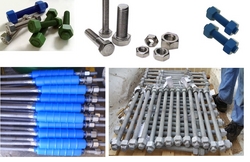BOLTS
A screw, or bolt, is a type of fastener, typically made of metal, and characterized by a helical ridge, known as a male thread(external thread) or just thread, wrapped around a cylinder. It is an inclined plane wrapped around a nail. Some screw threads are designed to mate with a complementary thread, known as a female thread (internal thread), often in the form of a nut or an object that has the internal thread formed into it. Other screw threads are designed to cut a helical groove in a softer material as the screw is inserted. The most common uses of screws are to hold objects together and to position objects.
A screw will almost always have a head on one end which contains a specially formed shape that allows it to be turned, or driven, with a tool. Common tools for driving screws include screwdrivers and wrenches. The head is usually larger than the body of the screw, which keeps the screw from being driven deeper than the length of the screw and to provide a bearing surface. There are exceptions; for instance, carriage bolts have a domed head that is not designed to be driven; set screws often have a head smaller than the outer diameter of the screw; J-bolts have a J-shaped head which is not designed to be driven, but rather is usually sunk into concrete allowing it to be used as an anchor bolt. The cylindrical portion of the screw from the underside of the head to the tip is known as the shank; it may be fully threaded or partially threaded.[1] The distance between each thread is called the "pitch".
The majority of screws are tightened by clockwise rotation, which is termed a right-hand thread; a common mnemonic device for remembering this when working with screws or bolts is "righty-tighty, lefty-loosey." Screws with left-hand threads are used in exceptional cases. For example, when the screw will be subject to counterclockwise torque (which would work to undo a right-hand thread), a left-hand-threaded screw would be an appropriate choice. The left side pedal of a bicycle has a left-hand thread.
NUTS
A nut is a type of fastener with a threaded hole. Nuts are almost always used opposite a mating bolt to fasten a stack of parts together. The two partners are kept together by a combination of their threads' friction, a slight stretch of the bolt, and compression of the parts. In applications where vibration or rotation may work a nut loose, various locking mechanisms may be employed: Adhesives, safety pins orlockwire, nylon inserts, or slightly oval-shaped threads. The most common shape is hexagonal, for similar reasons as the bolt head - 6 sides give a good granularity of angles for a tool to approach from (good in tight spots), but more (and smaller) corners would be vulnerable to being rounded off. It takes only 1/6th of a rotation to obtain the next side of the hexagon and grip is optimal. However polygons with more than 6 sides do not give the requisite grip and polygons with less than 6 sides take more time to be given a complete rotation.Other specialized shapes exist for certain needs, such as wing nuts for finger adjustment and captive nuts for inaccessible areas.
Nuts are graded with strength ratings compatible with their respective bolts; for example, an ISO property class 10 nut will be able to support the bolt proof strength load of an ISO property class 10.9 bolt without stripping. Likewise, an SAE class 5 nut can support the proof load of an SAE class 5 bolt, and so on.
A wide variety of nuts exists, from household hardware versions to specialized industry-specific designs that are engineered to meet various technical standards.
- Product Details
- Brand :
- Place of Origin : UAE
- FOB Price : AED 1
- Minimum Order Quantity : Not Given
- Supply Ability :
- Packaging & Delivery
- Packaging Detail : Carton Boxes, Wooden Pallets, Wooden Boxes
- Delivery Detail : Not Given
|
Other Products
|




